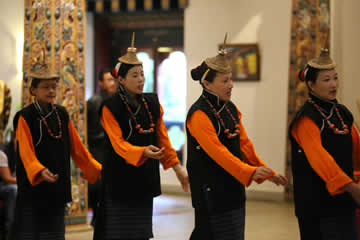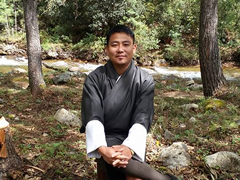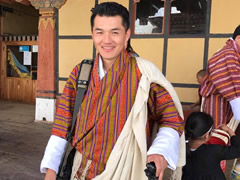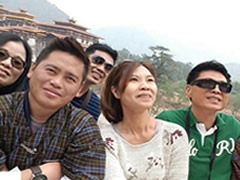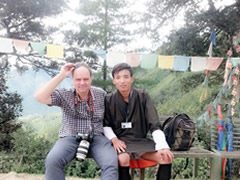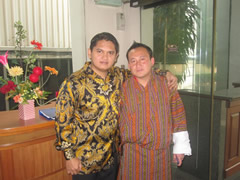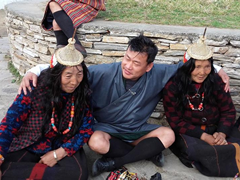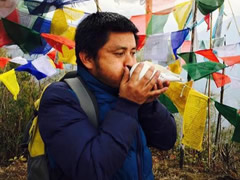Thimphu is the capital of Bhutan that combines a natural small-town feel with a new commercial exuberance that constantly challenges the country's natural conservatism and Shangri La image.One of the most curious features of Thimphu is that it is the only capital city in the world that does not use traffic lights. Instead a few major intersections have policemen standing in elaborately decorated booths (small pavilions), directing traffic with exaggerated hand motions.
What are the things going to see in Thimphu?
Places to visit in Thimphu / Different Sightseeing's in Thimphu
- Memorial Stupa
- Changgangkha Lhakhang
- Simtokha Dzong
- Tashichoidzong
- Buddha Point
- Nunnery
- Tango Monastery
- Pangrizampa
Memorial Stupa
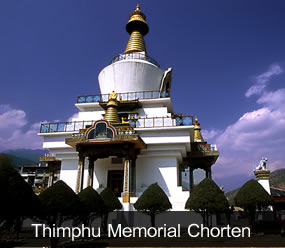 The Memorial Chorten, also known as the Thimphu Chorten, is a stupa built in memory of the 3rd King of Bhutan, Jigme Dorji Wangchuk by his mother Queen Ashi Phuntsho Choden Wangchuck.
The Memorial Chorten, also known as the Thimphu Chorten, is a stupa built in memory of the 3rd King of Bhutan, Jigme Dorji Wangchuk by his mother Queen Ashi Phuntsho Choden Wangchuck.
Legend has it that the 3rd king had three wishes before he died:
1. to build the 1000 statutes of Buddha to represent the body of Buddha
2. To write 108 volumes / Scripts of teaching of Buddha to represent the speech of Buddha
3. And to build the stupa to represent the mind of Buddha
Unfortunately, in the year 1972 at the age of 46, he died in Kenya, South Africa. He could fulfill his two wishes only- to build 1000 statutes of Buddha and to write 108 volumes / scripts of teaching of Buddha which we can still see in Tashi choedzong.
In order to fulfill the desire of his late son the third king of Bhutan, Ashi Phuntsho Choden built the stupa coinciding with the coronation ceremony of 4th king Jigme Singye wangchuk in the year 1974. The stupa was built containing a temple like of Dungtse lhakhang. Since the stupa represents the mind of Buddha , it contains the most important religious test, valuable relics and statues. The three different kinds of statutes that we see inside are the:
1. Base: Vijrakila ( Phurba) : Guru Rinpoche joined the power with thousands of God and his consort manifested as vijrakila and subdued the eight categories of the evil spirits who become the protector deities. So if we pray to Vijrakila then evil forces and black magicians cannot harm and destroy us.
2. Middle: Kagye: the eight orders of Guru Rinpoche so when someone dies we perform to liberate to the peace.
3. Top: Gongdu: the nine collective thoughts of Guru Rinpoche, so if we pray to him, he has power to liberate to the peace.
We can also witness the real citizens of Bhutan unlike the one’s we see in the town. The more relics it had the more value it is. It is believed that the stupa attempt to fly so that’s why it is chained in four directions. However it is opened only in the auspicious day like 8th, 10th, 15th, and 30th of the lunar calendar. So we as a human circumambulate the stupa to spread the teaching/ dharma with every step we take praying for all sentient beings.
Changgangkha Lhakhang
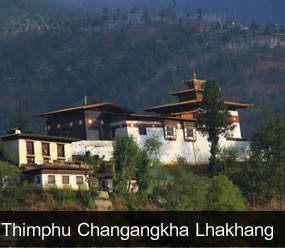 The temple is one of the oldest in Thimphu, built in the 12th century and is located above the main town of Thimphu overlooking the Thimphu valley. The site was chosen by Phajo Drugom Zhipo who came from Ralung in Tibet. Later his son Nyima built the temple in the year 1219.The monastery houses Chenrizig (Avolokitesawara), an 11-headed, thousand-armed manifestation as the central statue. The prayer books in this monastery are larger than the usual Buddhist texts.
The temple is one of the oldest in Thimphu, built in the 12th century and is located above the main town of Thimphu overlooking the Thimphu valley. The site was chosen by Phajo Drugom Zhipo who came from Ralung in Tibet. Later his son Nyima built the temple in the year 1219.The monastery houses Chenrizig (Avolokitesawara), an 11-headed, thousand-armed manifestation as the central statue. The prayer books in this monastery are larger than the usual Buddhist texts.
The lhakhang is considered to be the home of the guardian deity of all the children born within Chang valley. Parents traditionally come here to get auspicious names for their newborns or blessings for their young children from the protector deity Tamdrin. The new born babies are named as Tandin (originating from the name of the god Tamdin-Hayagriva) and sonam (Phajo’s consort Sonam Peldon).
The main guardian deity is named Dom-Tshang.
History
There was a great master in Tibet Known as Tshangpa Gyaray who lived during the 12th century. One day he built the monastery and was looking up in the sky wondering what name I should give to my monastery. So when looking up the sky he heard thundering thrice. So even now we believed that thundering is sound made by the dragon. So he named the monastery as Druk Choeding Monatery and his teaching was known as Drukpa Khayud. Druk means the word derived from the dragon. The state region we practice now was founded by Tshangpa Gyaray.
So after he founded the school he passed all his teachings to his nephew who was known as Sangay Onray. After passing all his teaching Tshangpa Gyaray passed away and during the cremation, from the body a born relic appeared which is in a size of a tiny gran and was known as Rangjung kharsapani. This Rangjung Kharsapani believed to be one of the important relics and was kept secret in Tibet.
So before Tshangpa Gari died he prophesied that a boy from eastern Kham will come to seek his teaching. He asked his nephew Sangay Ongray to preach the boy and send him south of Tibet where his destiny lies. According to the prophesy , after Tshangpa Gari’s death, Phajo Drugom Zhipo came in search of the master, he was taught by Sangay Onray and has sent to south of Tibet which is Bhutan. He was invited by the protector deities Mahakala and was received by the Hoptsho Lam.
While in Bhutan, he encountered a group of girls on the opposite bank of the wangchuu. Amongst the girls, he saw a very beautiful girl Sonam Peldon who possesses the every quality of dakini. They sang each other along the way and finally met at Lungtenzampa Bridge (the bridge of Prophesy). They married and Khandrom Sonam Paldon gave a birth to seven sons.
One day when Sonam Paldon went to collect firewood, Phajo Drugom Zhigpo took all of his seven childrens to the Wangchu River because out of his supernatural power he knew that some of his son’s will not help in spreading the Buddhism. There we proclaimed that ‘If you are the spiritual son of Guru Rinpoche, you will help me in spreading my dharma but if you are the spiritual son of demon, may you be washed away by the river’. After praying he threw all his seven children’s to the river and three sons were washed away by the river. The four sons remains from the four direction indicating they the spiritual sons of Guru Rinpoche and will helped phajo’s teaching in the four corners of Bhutan.
The four sons were:
Nyima
Dampa
Garton
Wangchuk
It was Phajo Drugom Zhigpo who bought Drukpa Kagyud to Bhutan which is the state region today. Phajo died at the age of sixty eight and many says that he was poisoned. So later, Nima built the Changangkha Lhakhang in the year 1219 and statute of Avolokitesawara ( the deity of compassion) in the sitting positions according to his prophesy and some says Phajo manifested in this posture when we was alive.
Simtokha Dzong
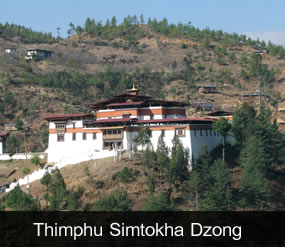 Simtokha literally means “Atop a Demon” also known as Sanga Zabdhon Phodrang is located around 5km south of Thimphu center. It I the first Dzong built in 1629 by Zhabdrung Ngawang Namgyel who unified Bhutan.
Simtokha literally means “Atop a Demon” also known as Sanga Zabdhon Phodrang is located around 5km south of Thimphu center. It I the first Dzong built in 1629 by Zhabdrung Ngawang Namgyel who unified Bhutan.
Known to Supernatural power of Zhabdrung Ngawang Namgyel, he was invited by the people of Simtokha to subdue the demon who is bringing suffering’s to the people of that valley. After the invitation, Zhabdrung Subdued the demon and demon is said to have emerged inside the big rock.
That’s how he built the Dzong on top of the rock and is the first dzong system introduced in Bhutan thus deriving the name sinmo (demon), do ( stomach) and kha (on). During its construction Simtokha Dzong was attacked by an alliance of Tibetans and five Bhutanese lamas from rival Buddhist schools who were opposed to the Zhabdrung's rule. The five Bhutanese lamas are Lhapas, Nenyingpas, Barawas, Kathogpas and Chagzampas. However the Zhabdrung gained the power over Tibetans and five Bhutanese lamas and has built the Simtokha Dzong completely. Today more than 60 monks reside over the semtokha Dzong.
Before the Dzong function as the school for language and cultural studies but now the the institute has shifted to Trongsa the central part of Bhutan. It is also said that the father of 1st king Jigme Namgyel lived in the dzong after retirement to overlook all the directions.
Inside the dzong we can see the main statue of the future Buddha and the 8 Bodhisattvas. The 8 bodhisattvas are:
1. Chenrizig 2. Jampelyang 3. Chana dorji 4. Namkhai ningpo 5. Sai Ningpo 6. Joe jampa 7. Dorba Namsay and 8. Kuntozangpo
The uniqueness of Simtokha Dzong is it has many doors and 12 different shapes. Another interesting aspect of the dzong is that it contains the bed chambers of both Zhabdrung Ngawang Namgyel and Jigme Namgyel two of the most important figures in Bhutanese history. Zhabdrung was the leader that first united Bhutan as a nation and Jigme Namgyel was the father of the first King of Bhutan Ugyen Wangchuck. The main protector deity is Mahakala.
Tashichoidzong
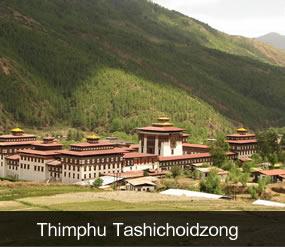 The original Thimphu dzong (the Do-Ngön Dzong, or Blue Stone Dzong) was built in 1216 by Lama Gyalwa Lhanapa founder of the Lhapa branch at the place where Dechen Phodrang Monastery now stands on a ridge above the present Tashichö-dzong.
The original Thimphu dzong (the Do-Ngön Dzong, or Blue Stone Dzong) was built in 1216 by Lama Gyalwa Lhanapa founder of the Lhapa branch at the place where Dechen Phodrang Monastery now stands on a ridge above the present Tashichö-dzong.
It was first destroyed by the group of lamas during the battle. In 1641 Zhabdrung Ngawang Namgyal acquired it but finding it too small, he built another one, known as the lower Dzong. The original dzong was destroyed by fire in 1771 and everything was moved to the lower dzong. The new building was later expanded several times over the years. It was damaged during an earthquake in 1897 and rebuilt in 1902. It was the third king who have enlarged Tashichoidzong in 1968 and moved his capital from Bumthang and still now Thimphu is the capital of Bhutan.
It presently houses the throne room and offices of the King, two other ministers and the summer capital of monastic body where chief abbot Jekhenpo study and live in the dzong with more than 600 monks
Buddha Point
 As Bhutan being the last Buddhist kingdom in the world housing many holy and high value scared places; the great master lama Tshering Wangdi was prophesied to build the world largest statute in Bhutan for the wellbeing, longevity and peace in the world.
As Bhutan being the last Buddhist kingdom in the world housing many holy and high value scared places; the great master lama Tshering Wangdi was prophesied to build the world largest statute in Bhutan for the wellbeing, longevity and peace in the world.
Accordingly, he approached to Jekhenpo, the chief abbot of Bhutan about his plan. Since Bhutan is in limited budget, so both Jekhenpo and the lama Tshering Wangdi approached fourth King of Bhutan. The fourth king of Bhutan was very happy about the plan and map that they have shown. Since Bhutan is having insufficient budget/fund to build the largest statute, he promised to help with other utilities such as land, road, water supply and electricity.
In order to choose the suitable place to build the statute, they approached the prime minister of Bhutan Jigme Yoezer Thinley in the year 1998. Accordingly, prime minister had given five different types of land for the construction of statute which ever suitable was to be chosen.
One early morning when Jekhenpo was praying for the good location he saw the gradient of light chinning from the current location. So taking this as a special omen, they started laying up the foundation in the year 1998.
Due to limited budget , Lama Tshering Wangdi went to Hongkong, Taiwan , China and Singapore for sponsorships by explaining his plan and drawing’s. Most of the them were very happing and willing to sponsor to build the Buddha statute. With the help of donations lama Tshering Wangdi could build the largest statute of Buddha which is of 51.2 m high.
Since we do not have facilities, the parts of the Buddha statute was built in Hongkong and then shifted here. In the body of the Buddha it contains one hundred thousand ( 100,000) Buddha and twenty five thousand Buddha’s with different inches.
After completion of the statute Lama Tshering wangdi wanted to handover to the Government because he told he cannot take care of all those valuable relics which contains inside.
It is believed that it will be the largest Buddha statute in the world overlooking all valleys in Thimphu. It took 18 years to construct the statute and base is yet to complete.
Lama Tsehring Wangdi is a founder, architect and builder of the statute.
Nunnery
Nunnery (Thangtong Dewachen Nunnery)
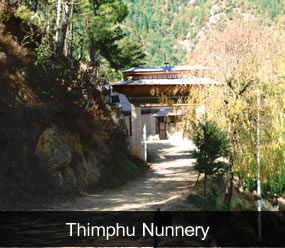 The nunnery, popularly known as Zilukha Anim Dratshang is located above Zilukha Lower Secondary School, overlooking Tashichodzong in Thimphu valley. It is a few minutes’ drive from the main Thimphu town.
The nunnery, popularly known as Zilukha Anim Dratshang is located above Zilukha Lower Secondary School, overlooking Tashichodzong in Thimphu valley. It is a few minutes’ drive from the main Thimphu town.
History
Drubthob Rikey Jadrel, the 16th emanation of Thangtong Gyalpo (1361-1485), the Tibetan saint renowned as the great Siddha and the builder of numerous iron chain bridges across the Himalayas founded the nunnery in 1976. Drubthob Rinpoche as he is popularly known while on his stay at Paro was invited by Lama Sonam Zangpo, the grand father of Dzongsar Jamyang Khentse Rinpoche to Thimphu. At Thimphu he got an audience with Lama Sonam Zangpo and His Holiness Dilgo Khyentse Rinpoche popularly known as Agay Khyentse.
The land where the nunnery stands today was owned by an old man who did not have any relative. He was building a house at the place but before he could complete it he passed away. It is said that the place was later offered to Drubthob Rinpoche by the people of the locality. The Drubthob wanted to make a statue but his patron came forward to build a monastery with the aim of propagating Buddhism in general and the teachings associated with Thangtong Gyalpo in particular. The construction was supported by many patrons and volunteers.
Under the aegis of Drubthob Rikey Jadrel, the nunnery started with about 45 nuns but today it has over 60 nuns. It is a two storied building with the main temple on the ground floor. On the top there are two chambers build for Drubthob Rikey Jadrel. One of the chambers houses a statue of Buddha Yodpame (Amitabha). The nunnery follows the Jangter lineage and Abham Terchoe of Nyingma School and Shangpa Kagyu tradition.
Above the nunnery there is a drubchu (holy water) which served as a source of drinking water during the time of Drubthob Rikey. Today due to the increasing number of nuns, the government has provided better water facility. However the drubchu is still intact and is referred to as “Drubthobs Drubchu”.
The main relic of the nunnery is the statue of Thangtong Gyalpo. To its right is the statue of Neten Yenlajung (one of the sixteen Arhats) and to its left is that of Jetsun Dolma (Tara). Decorated with the murals of Guru Tshengay (eight manifestations of Guru Rinpoche), Yidam Tamdin (Hayagriva), Chenrizig (Avaloketeshvara), Chagtong Chentong (Avaloketeshvara with thousand arms and thousand eyes) and Tshepamey (Amitayus), the nunnery stands unique in itself. This is the only nunnery built by Drubthob in Thimphu. The mural of the entrance room is that of Neten Chudrug (Sixteen Arhats). Other relics consist of sixteen volumes of Bum (Hundred Thousand Verses of Prajnaparamita), Kanjur (translated words of Buddha) and Rinchen Terzo (precious teachings of great masters).
They perform the Phurpai ritual (ritual in honor of Vajrakila) for a week long from 23rd to 30th of the 10th month of Bhutanese calendar. A Mani Dungdup (chanting of the six syllable Avaloketeshvara mantra for 100 million times) is conducted in the fourth month. The devotees are always invited to join the nuns in reciting the six syllable mantra due to which the exact number of days for the ritual varies. On the 1st month starting from the 7th day till 15th, they perform the Zhingdup (ritual performed in honor of Yodpame). They also perform rituals on all the auspicious days of a month.
In 2003, fire broke out at the place but it did not destroy the main monastery. A dormitory is built on the site of the house which was destroyed by fire.
Tango Monastery
 Tango is located at the farthest region north of Thimphu. It is roughly 14 kilometers away from Thimphu town. Following the trail, the walk uphill takes about 40 minutes to reach the monastery.
Tango is located at the farthest region north of Thimphu. It is roughly 14 kilometers away from Thimphu town. Following the trail, the walk uphill takes about 40 minutes to reach the monastery.
History
The word Tango literally means ‘horse head’ and is derived from the deity Tandin (Hayagriva) that features the head of a horse. The revered place of Hayagriva was first recognized by Guru Rinpoche in the eighth century. In 1222 A.D. Phajo Drugom Zhigpo visited the place and while he was involved in his teachings in Dodeyna, he heard the neighing of a horse approaching from the direction of Tango. On approaching the place, to his surprise he saw a cliff, alleged to be the body of the deity Tandin, engulfed in flames. The deity appeared before him in person and prophesied that Phajo would build a meditation centre at Tango, marry the Dakini, Khando Sonam Peldon and lay the foundations for the Drukpa Kagyu School in Bhutan.
Tango was later visited by many other notable Buddhist saints including Lama Drukpa Kuenley – “the Divine Mad Man”, Drukpa Kuenley’s son Lama Ngawang Tenzin who discovered many treasures and relics from the sites, Mipham Tshewang Tenzin and Zhabdrung Ngawang Namgyel. It was here in Tango that Zhabdrung Ngawang Namgyel meditated and also wrote down the Nga Chu Drugma – My Sixteen Accomplishments. The corpse of his late father Tenpai Nyima was also placed inside the cave of the deity Hayagriva.
The present day monastery was built in 1689 by Gyalsay Tenzin Rabgyal at the age of 51. The three storied monastery was built with the help of the locals and was completed within two months. Gyalsay Tenzin Rabgyal was born to Tshewang Tenzin and Damchoe Tenzin, who was a daughter to Changangkha Lama. He was adopted by Zhabdrung and was ordained in the monk body. He was trained in both monastic and secular systems of governance in order to succeed Zhabdrung Ngawang Namgyel. Thus he was known as Gyalsay – “the Heart Son”. He was addressed as Gyaltshab, representative of Zhabdrung Ngawang Namgyel in the year 1650 and later in 1672 he was known as Thri Rinpoche - Lam on the throne of Zhabdrung. Tenzin Rabgye was enthroned as the 4th Desi in 1680. Gyalse Tenzin Rabgye passed away in 1696 at the age of fifty nine and it is believed that the statues shed tears at the time of his passing. Still today these tears can be traced out on the wall paintings while visiting the Dzong. There is a stupa known as Kudung chorten of Gyalse Tenzin Rabgay where his ashes are kept.
The sandalwood trees found are supposed to be the walking sticks of Phajo. The Chorten, stupa found beside the cypress trees is the place where Khando Sonam Peldon attained enlightenment. At the time of enlightenment she left behind all her belongings. The chorten was used to house them. Phajo after his meditation also built a small temple known as Tandin Nye.
In 1966the 64th Chief Abbot of Bhutan Jamyang Yeshey Singye and Her Royal Highness the late Queen Ashi Phuntsho Choden appointed Lam Tenzin Dhendup as the first head of the meditation centre of Tango. Later His Holiness Dujom Rinpoche visited the place on an invitation from the Queen mother Ashi Phuntsho Choden. The 69th Chief Abbot Geshey Geden Rinchen served as the head of the meditation centre for around twelve years and renovated the old dismantled portion of the Utse with assistance from the Queen mother Ashi Kesang Choden Wangchuck. His Holiness Dilgo Khentse Rinpoche was invited for the consecration ceremony. The monastery was renovated in 1977 by her Majesty the Queen Mother Ashi Kesang Choden Wangchuck. In the middle of the courtyard there is a natural spring which flows throughout the year. In 1986 under the command of the 4th Druk Gyalpo King Jigme Singye Wangchuk, the renovation project for the Dzong started and in the same year the College for Buddhist studies was started. It was successfully completed in 1996.
The monastery has six temples that include Trulku lhakhang, Longku lhakhang, Choeku lhakhang, Guru lhakhang, Namsey Lhakhang and Gonkhang (inner chapel dedicated to deity).
The main statues and idols in Tulku lhakhang are of Buddha Shakya Muni (the present Buddha), Sangay Marmey Zed (Dipankara-the great illuminator) and Jowo Jamba (Maitreya) made out of precious metals, specifically gold and copper. Other statues that can be seen are eight different Buddhas known as Jang Sem Nye Wai Say Chen Gyad (Jamyang, Chador, Chenrizig (Avaloketeshvara), Namkhai Nyingpo (Akashagarba), Dripa Namsel, Saye Nyingpo, Jamba and Jampel Zhenu Jurpa sculptured by Tulku Zing and Druk Chophel.
The Gonkhang houses the statue of Pel Yeshey Gonpo (Mahakala), the protective deity holding a skull. The skull is believed to be the skull of the famous King of Tibet, Thrisong Detsun.
Longku Monastery holds the statue of Avaloketeshvara – the Buddha of compassion. The statue was sculptured by a Nepalese artist named Pentsa Dewa.
Choku lhakhang has the statue of Tshepamed – the Buddha of long life (Amitayus). It was also sculptured by Pentsa Dewa, with the assistance of Zhabdrung Ngawang Namgyel and Gyalse Tenzin Rabgye. The main statue in the Guru Lhakhang is the statue of Guru Padmasambhva and his eight manifestations. Namsey lhakhang is home to the statue of Namsey (Vaisravana – the god of wealth).
The chamber of Gyalse Tenzin Rabgye houses many statues, which include those of Guru Padmasambhava surrounded by bodhisattvas Tshepamed (Amityus), Dorji Chang (Vajradhara) and Sangwai Dagpo; the Kagyu masters Tilopa, Naropa, Marpa, Gampopa, Phag Druk, Ling Ray Pa, Singye Tshechen Gu (Nine Lions), Rig Sum Namtrul, Gyalwang Je, Ngawang Chogyal, Choki Drakpa, Tenpai Gyeltshen, Ngagi Wangchuk, Kuenkhen Pema Karpo, Mipham Chhogyal, Tenpai Nyima, Zhabdrung Ngawang Namgyal, Drukpa Kuenley, Ngawang Tenzin, Tshewang Tenzin and Gyalse Tenzin Rabgye. The chamber also holds many images and paintings, specifically those of Tsangpa Gyaray, Drung Damchoe, Khey Chen Sonam Yoezer, Dechog, Dorji Phagmo, Khenchen Bodhisattva, Dragpo Marchen, Drupthob Shawa Ripa, Dorji Rabgye, Jimba Gyaltshen, Phajo Drugom Zhigpo, Chenrizig (Avaloketeshvara), Dolkar, Drolngoen, Jamkar, Nangso Rinchen Zangpo, Drukpa Kuenley, Drupthob Ngawang Tenzin, Tshewang Tenzin, Zambala Nagpo (Jambala-god of wealth), Ngawang Chogyal, Dorji Sempa, Jampel Mar Ser, Chana Dorji,(Vajrapani) Lopen Ludup, Jowo Jampel Atisha, Dupchen Shacha Phel, Kunpang Jumai Gar Khen, Je Rinpoche Ngawang Tenzin Rabgye and Norjuema.
The most important festival held at Tango is the Yarney (summer retreat) which first started in Tango in 1967. It begins on the 15th day of the 6th month of the Bhutanese calendar and concludes on the 30th day of the 7th month of the Bhutanese Calendar.
Pangrizampa
Location
 Pangri Zampa lhakhang is located at the extreme north of the Thimphu valley. The temple is a few minutes walk away from the Dechencholing market and falls under Kawang geog.
Pangri Zampa lhakhang is located at the extreme north of the Thimphu valley. The temple is a few minutes walk away from the Dechencholing market and falls under Kawang geog.
History
In the ninth Rabjung corresponding to the year 1529, Lama Ngawang Chogyal along with his son came from Ralung in Tibet to Bhutan and visited Pangri Zampa. There he built a temple and named it Druk Phodrangding “The castle of the Dragon” a similar name that was given to a monastery in Tibet. However today it is commonly known as Pangri Zampa lhakhang.
At the time of Zhabdrung’s arrival in Bhutan in the 17th century, the Lam Kha Nga (five groups of Lam) had established themselves as powerful lords and had most of the western region under their control. After the arrival of Zhabdrung, he slowly began to dominate and as a result the Lam Kha Nga abandoned their establishments that were just above the temple built by Lama Ngawang Chogyal. Thus the name Pangri (Pang: meaning leaving behind, Ri: meaning mountain) came into being. The name “Pangri” is also derived from the Bhutanese word Pang, which means flat land and Ri-meaning Mountains. The temple is also known as Pangri Zamdong as it is located in front of the Pangri Bridge.
The cypress tree found at the entrance of the temple is also considered sacred. It is said that when Zhabdrung Ngawang Namgyal was in Tibet, he constantly had a dream of a raven pointing southward. Taking it as a good omen, Zhabdrung Ngawang Namgyal traveled southward to Bhutan. When he reached Bhutan he was guided to the present place where the Lhakhang is located. Some people say that the raven which guided Zhabdrung all the way from Tibet disappeared into the tree. For this reason, people consider the tree sacred and worship it to this day.
The temple was built with the aim to spread peace and happiness through the practice of Buddhism. Ngagi Wangchuk, the younger son of Lama Ngawang Chogyal, started a retreat centre in the temple. Today, the temple has an educational centre for Astrology known as Zhungtsi Lopjong Pelkhang. This learning centre was first opened in 2003. At present there are more than eighty five monks. It is taken care of by the Central Monastic Body of Bhutan. The temple is a four storied building. During ancient times the ground floor of the temple was used as a store room by the Kagyu Lamas. Today it houses the young monks studying Astrology. The first and second floor of the temple are used to house the teachers and as classrooms. The topmost floor houses the main chapel.
The Lhakhang was also the residence of the 18th Chief Abbot of Bhutan Jamyang Gyeltshen (1797-1803). The temple has a chapel of the Kagyu Lama and a sacred chapel of the guardian deities of Bhutan, Yeshey Gonpa and Palden Lhamo.


